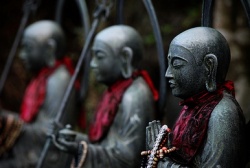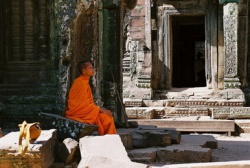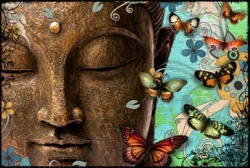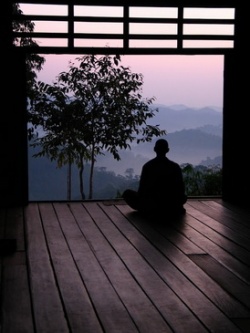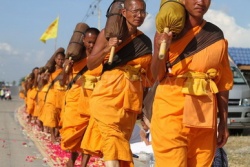Becoming a Buddhist
As is the case with other belief systems, people may think of themselves as Buddhist having been born into a family of Buddhists, or into a culture where Buddhism is predominant, and may never actually go through any ritual.
It is not necessary to give up any religious affiliation to practice Buddhism unless that religion demands actions that contradict Buddhist principles. Also, it is not generally necessary to change one's habits of diet, dress or relations with others, though some people choose to do so. By the way, in many cultures Buddhists are not vegetarian.
Khenpo Karthar Rinpoche says that giving up other spiritual practices is not necessary to become a Buddhist. He says, "Just because you make a new friend, you don't have to give up your old friend."
The procedure by which one makes the choice to become a committed Buddhist however, is known as Taking Refuge. We take shelter in the protection and guidance of The Three Jewels: Buddha, Dharma and Sangha. Many people say that they experience a real sense of relief on the occasion of taking Refuge, as if they have really come in out of a storm to a place of warmth and comfort.
Dress
To prepare for the ritual, people generally bathe to feel fresh and to symbolically wash away the past. It is a traditional thing to do in many different cultures, and it helps create a feeling of purification and rebirth. Some people, knowing about the hair-cutting tradition, might arrange their hair so that the symbolic gesture of the Buddha's representative will be easy. In keeping with the aspect of renunciation, avoid the wearing of perfumes and other scented products. Also, strong odours can be distracting, even annoying, to people around you.
People sometimes put on new or festive clothing. There is no requirement except to dress modestly and comfortably.
Take into consideration that the ritual postures can expose more than is appropriate, and that celibate people may be present. We might think nothing of wearing shorts, sleeveless / form-fitting tops, hip-hugging pants that reveal too much especially when the person is seated and so on, but other people, certainly those of the older generation, may feel uncomfortable.
The Ritual
In the presence of a representative of the Buddha's sangha or community; that is, an ordained Buddhist teacher, priest, monk or nun, the individual asks for admission to the Buddhist community. This is usually in front of a shrine with representations of the Three Jewels on it including a statue of Buddha and offerings of food, flowers and traditional bowls of water along with incense and an offering of light in the form of a flame. A representation of pleasant sounds, usually represented by a pair of cymbals, is also present on the shrine.
The teacher explains that there are 3 objects of Refuge: Buddha, Dharma and Sangha. He or she will explain why and how they are suitable Refuges. Then come the requirements, which are: You understand what they are doing, you come of your own free will (the question will be asked of you and you respond truthfully) and you usually have to promise to observe the precept not to take any life intentionally.
There is also advice given on how to respect the 3 Jewels.
The person desiring Refuge kneels on one knee (the right one) as in ancient Indian illustrations, that is with the palms joined below the chin. This pose is called in Sanskrit, anjali.
You then make the request for Refuge three different times, each time beginning with an identification of who it is who is asking. That is, you give your full name. (The third time, your name will have changed.) It is made using a traditional formula that the teacher or Lama will model and explain, in the language of the tradition to which they belong and/or in the local language such as English, French, Chinese, etc.
There will probably be a few people there, kneeling in a row. If there are many, it can get a bit tiring as you wait your turn for the next part of the Refuge ceremony. Older, stiffer people might want to practice getting up and down from the one-knee-up kneeling position at home before the actual ceremony.
The monk or lama will then beckon each person to approach, and a tiny lock of hair is cut from the crown of the head. The crown [very top of the head] is the highest part, and symbolizes an offering of the best of oneself. The cutting ritual is also in the tradition of those who leave everything behind, symbolically experiencing their own death to become renunciates sannyasin or sadhus.
Then the "new' person says a formula of thanks that is also a confirmation that he or she is doing this of their free will. It translates as "I am glad."
You return to your place in line and wait till all have gone through the hair-cutting. Some people might wish they had worn knee pads!
The lama will then address you and make a symbolic action of transmission. This is in the tradition of shaktipat; it marks the moment in time when the change is imparted. This serves also to remind you to think of yourself in a new way from that moment.
Finally, you will be given a new name symbolic of your "entering the stream" and will again repeat the formula but now with the identity of a new Buddhist.
There will usually be an opportunity at the end, for the congregation to file up past the lama's chair or lectern for a few words, a "membership card" with the lineage of transmission and dharma name, and for blessings. The traditional greeting from you is the presentation of a thin white silk (or simili-silk -- rayon) scarf called a katta.
A katta or kathag, is a sheer white silk scarf used in the Tibetan culture as offerings to people instead of the garland of marigolds or other flowers used in India (and Polynesia.) In Mongolian practice, the scarf is blue.
Often the teacher will return it by placing it around your shoulders as a form of blessing. Those wishing to make a monetary (or other) offering to the lama can do so at this time. It is usually prepared beforehand by putting it in a white or red envelope. Then when the katta is offered you can place it on the lama's table. Otherwise, you can offer a gift of money to be passed on later by an attendant or sangha member.
This offering is, again, in the tradition of Indian guru and student. In ancient times, people desirous of certain precious teachings were put to the test. Along with patience and devotion, generosity is a very important quality in the student. They sometimes donated all that they owned in order to be adopted into the community of a renowned guru. In early days, the donation took the form of gold dust, a piece of metal work, of gemstones or of food or fuel. Today, money is a more useful offering because it can be transferred easily for use in the guru's own projects for helping others, and for the maintenance of dharma centres.
The Lord/Lady of Refuge
The Refuge ceremony is reminiscent of the mediaeval ritual of swearing fealty to a liege lord. He/she offered protection and the possibility of improving one's lot in life, and the vassal offers his service in exchange. The important difference here is that you are not primarily taking refuge in the human before you, but in the Three Jewels. Also, it is up to you to maintain the relation; there are no threats involved.
You can also take refuge more than once, if you desire. Sometimes people want to renew their commitment or to have the experience with a different representative of the 3 Jewels, or in a different Buddhist tradition -- or even to get a "nicer" name. It is reported, however, that people who do that just to get a new dharma name, often find the "new" name is similar to the old!
Two Kinds of Refuge Ceremony
On May 21, 2008, at Karma Triyana Dharmachakra in Woodstock, NY while on his first visit to the West, HH Karmapa said that there are two aspects to taking refuge: as a blessing and/or as a commitment.
Anyone can readily Take Refuge in the 3 Jewels, but to take the Vows of Refuge, is a more serious undertaking. One must aspire to abjure certain things, such as:
not to intentionally take any life;
another is not to frequent bad companions; ie, those who could lead us from our chosen path.
(At that time, and since the venue was very crowded and time was limited, Karmapa then performed an abbreviated Refuge ceremony of the first type. He suggested that people should seek further information / instruction before taking actual Refuge Vows.)
In 2011, while at his seat in the USA, when Refuge was offered as a blessing rather than a commitment, he emphasized that it is the Buddha's system (the Dharma) that is most important. We take refuge in the Buddha because it was he that developed and agreed to teach the way to lessen suffering and enable happiness.
Refuge when there is no lama
If you have studied the Four Noble Truths and have read enough about Buddhism to want to "enter the stream," and if you feel a certain sense of urgency about it and do not expect to meet with a lama or an ordained member of the sangha because you live in an isolated area, you can Take Refuge before a book of Buddhist sutras and an image of Buddha Shakyamuni. In the opinion of many, even the image is not essential because it is the Dharma, the Buddha's teachings, that really provides the refuge, and it symbolizes the Buddha. (Any sutras should be elevated and always treated with respect.)
Prepare a clean shrine area putting out remembrances of the Buddha's Body, Speech and Mind and if they are available, the 7 bowls of clean water and other offerings.
It is a good idea to Take Refuge again before a lama or Buddhist preceptor when you finally get the opportunity. A group of 3, 5 or 7 people (at least) is considered auspicious, but is not essential.
In Mahayana Buddhism, the bodhisattva vow is incorporated in the refuge vow:
From now until the time of Enlightenment, I take refuge in the Buddha, the Dharma and the Sangha, for the benefit of all mother-beings.
When there is no teacher: Advice from Lama Lodru practicing despite the fact that you do not yet have a teacher.
The Meaning of Taking Refuge
Venerable Lama Karma Samten Gyatso responds to queries:
Question: Please would you say something about Taking Refuge?
Answer: Taking Refuge is a decision of commitment to Buddhism. It is also a commitment to practice from that day forward. The principle of Taking Refuge also means a commitment of taking care of yourself and others.
When we Take Refuge it is in the Buddha, Dharma and Sangha. Buddha is our destination and Ultimate Refuge, Dharma is the Path, and the Sangha are our Spiritual Friends. These are the Three External Objects of Refuge.
The Three Internal Objects of Refuge are your Body, Speech and Mind. Your Body is the Sangha, your Speech is the Dharma and your Mind is the Buddha. Mind is regarded as the Ultimate Refuge because, when you die, it is the mind that continues. The external objects of your Body, Speech and Mind are left behind.
Mind, in its Ultimate form, has three different aspects. These are the Dharmakaya, Sambhogakaya and Nirmanakaya. Dharmakaya is the Ultimate aspect of Enlightenment, Sambhogakaya is the communication aspect between the Nirmanakaya and Dharmakaya, and Nirmanakaya is the manifestation aspect.
When you analyze your mind, you are unable to find it. This part of Emptiness is called Dharmakaya. It may be un-findable but none-the-less there is something there. This is the communication aspect, the Sambhogakaya. The recognition of how-ever many thoughts arise in your mind is the manifestation aspect, the Nirmanakaya. As these three forms are the ultimate qualities of your mind, they are the Ultimate Objects of Refuge. This is what constitutes the Ultimate Refuge: Dharmakaya is the Buddha, Sambhogakaya is the Dharma, and Nirmanakaya the Sangha.
By Taking Refuge, you make a commitment to take care of and respect the teachings. This also means you take care of your mind because your mind is the Ultimate Refuge. As these same qualities are to be found in the minds of every sentient being, you must also respect all other beings as well.
So, this is the sort of discipline involved in Taking Refuge.
